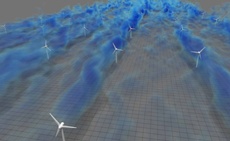New wind-farm computer simulations unlock increased power generation
10 Jan 2015
Researchers at Johns Hopkins University (JHU) have developed high-resolution computer simulations, done on the Trestles supercomputer at the San Diego Supercomputer Center at the University of California, San Diego, that take into account how the air flows within and around a wind-farm in unprecedented detail.
 | |
| Detailed simulations, which require the use of advanced supercomputers such as the ones at SDSC, allow researchers to study the flow in wind-farms in great detail. This image shows a visualization of the flow in a very large wind-farm obtained from a high-resolution simulation. The blue regions indicate the low velocity wind-speed regions (wakes) formed behind the turbines. Visualization by David Bock (National Center for Supercomputing Applications) and XSEDE (Extreme Science and Engineering Discovery Environment) as part of XSEDE's Extended Collaborative Support Services. |
The study, published recently in the Journal of Renewable and Sustainable Energy, challenges conventional wisdom that suggests the highest power output comes when the turbines are arranged in a checkerboard pattern.
As it turns out, the highest power results when the lateral offset of turbines is such that they are just outside each other's wakes. When this coincides with prevailing wind directions at a given site, this may in fact yield higher power levels, according to the researchers.
''As wind energy is becoming more important around the globe as a source for clean, renewable power, we're finding that understanding the effect of spacing and relative positioning of the turbines on the wind-farm is crucial for a good wind-farm design,'' said Richard Stevens, who conducted the research with Charles Meneveau and Dennice Gayme at JHU.
Stevens says, ''Wind-farm designers typically rely on simple computer models that predict the wake effects caused by the turbines. These models work well for smaller wind-farms, but become less accurate for larger wind-farms, where the wakes interact with one another as well as with the atmospheric wind.''
These overall effects are harder to predict, according to the researchers, who said the new computer simulations take into account the total interaction between the wind-farm and the atmospheric wind.
After comparing the results from very detailed wind-farm simulations with existing industry models, the research team developed a new model, called the ''coupled wake boundary layer model'', which can more effectively predict wind-farm performance.
''The benefit of high-fidelity computer simulations such as the ones we did using Trestles is that the flow in the wind-farm can be studied in detail to get insight about the main physical mechanisms that are important for the performance of very large wind-farms,'' said JHU's Meneveau.
''The use of Trestles and the support provided by SDSC's expert staff was of paramount importance for our research, which we hope will lead to more efficient and better thought-out wind-farm designs.''







.webp)























